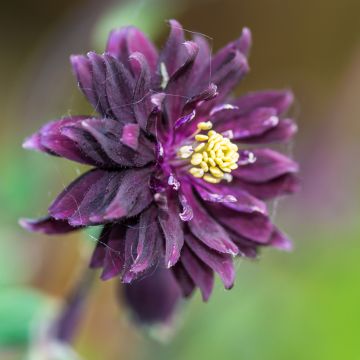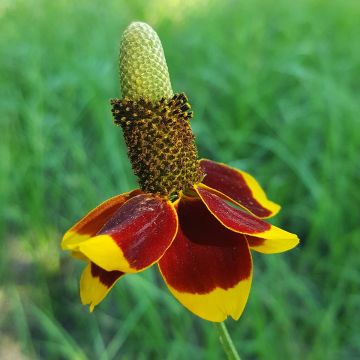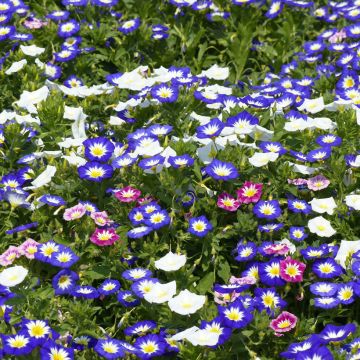

Graines d'Achillea Summer Berries F2 Hybrid - Achillée millefeuille hybride en mélange
Achillea x millefolium Summer Berries F2 Hybrid - Yarrow
Achillea x millefolium Summer Berries F2 Hybrid
Common Yarrow, Milfoil, Thousand-leaf, Nosebleed plant
Special offer!
Receive a €20 voucher for any order over €90 (excluding delivery costs, credit notes, and plastic-free options)!
1- Add your favorite plants to your cart.
2- Once you have reached €90, confirm your order (you can even choose the delivery date!).
3- As soon as your order is shipped, you will receive an email containing your voucher code, valid for 3 months (90 days).
Your voucher is unique and can only be used once, for any order with a minimum value of €20, excluding delivery costs.
Can be combined with other current offers, non-divisible and non-refundable.
Home or relay delivery (depending on size and destination)
Schedule delivery date,
and select date in basket
This plant carries a 6 months recovery warranty
More information
We guarantee the quality of our plants for a full growing cycle, and will replace at our expense any plant that fails to recover under normal climatic and planting conditions.
Would this plant suit my garden?
Set up your Plantfit profile →
Description
This mix of Achillea Summer Berries F2 Hybrid, also known as yarrow, quickly creates richly coloured masses of flat inflorescences, dancing above a highly aromatic feathery foliage. An explosion of colours that renews throughout the summer, ideal for brightening borders and slopes. Easy-to-grow perennial, even in dry and poor soils, these flowers are also spectacular in dried or fresh bouquets.
The Summer Berries F2 Hybrid yarrow is a perennial plant with stoloniferous growth habit, forming compact and erect clumps from spring onwards. It belongs to the Aster family. It is one of the many cultivars of Achillea millefolium native to Europe and Asia Minor. The plant, with its bushy and branched habit, reaches a height of 60 cm (24in) when flowering, with foliage measuring 20 to 30 cm (8 to 12in). It spreads over 60 cm (24in) and more. The inflorescence is a flat corymb, measuring 5 to 8 cm (2 to 3in) in diameter. The remarkably abundant flowering occurs from June to August. The flowers are actually heads, with tubular disk florets in the central part, while the peripheral florets are ligulate. These heads, appearing at the tops of the stems, form flat or slightly rounded corymbs, intensely coloured. They give rise to fruits called achenes. The stem is channelled and villous. The foliage is deciduous or semi-evergreen, aromatic and finely divided into strips. The leaves are bipinnately lobed, feathery and dark green in colour. The plant develops on the soil surface through stolons, allowing it to colonise large areas.
The Summer Berries F2 Hybrid yarrow will blend well in borders with cosmos, ornamental carrots or damask nigellas. It can be planted in a rock garden, on top of a wall, as a border or on a slope where it will contribute to stabilizing and protecting against erosion. This stoloniferous plant can be used as groundcover over large areas. It then allows you to avoid the necessary mowing of a lawn by replacing it in lightly trodden areas. It tolerates root competition from trees, making it a good groundcover also on the edge of woodlands. As it is easy to grow and withstands drought well, it is perfect for dressing the base of shrub roses or bordering a sunny bed.
Report an error about the product description
Flowering
Foliage
Plant habit
Botanical data
Achillea
x millefolium
Summer Berries F2 Hybrid
Asteraceae
Common Yarrow, Milfoil, Thousand-leaf, Nosebleed plant
Cultivar or hybrid
Other Achillea seeds
View all →Planting and care
Sow Achillea millefolium seeds from February to June or from September to October on the surface of a good compost and cover the seeds with a thin layer of vermiculite compost. Place in a mini greenhouse at a temperature of 15-24°C or enclose the seed tray inside a polyethylene bag until germination, which usually takes 1 to 3 weeks. Keep in the light, as this facilitates germination.
When the seedlings are large enough to handle, transplant them into 8 cm (3in) pots and grow them in cooler conditions. When the plants are well developed and there is no longer a risk of frost, gradually acclimatise the plants to outdoor conditions for 10 to 15 days before planting them outside. Transplant the plants at a distance of 60cm (24in) in open ground, in full sun in well-drained soils. September seedlings will spend the winter under a cold frame and will be planted outside the following spring.
Plant Achillea millefolium in any soil, even chalky, dry or moist but well-drained. It even adapts to clay soils. It will grow in partial shade but prefers full sun. In cool climates, planting can be done at any time of the year. In regions with hot and dry summers, it is preferable to plant in September-October so that the plant can establish its roots well during autumn and winter to withstand the following summer. It is advisable to cut back all the vegetation at the end of the season to encourage the growth of new shoots in spring.
Sowing period
Intended location
This item has not been reviewed yet - be the first to leave a review about it.
Similar products
Haven't found what you were looking for?
Hardiness is the lowest winter temperature a plant can endure without suffering serious damage or even dying. However, hardiness is affected by location (a sheltered area, such as a patio), protection (winter cover) and soil type (hardiness is improved by well-drained soil).

Photo Sharing Terms & Conditions
In order to encourage gardeners to interact and share their experiences, Promesse de fleurs offers various media enabling content to be uploaded onto its Site - in particular via the ‘Photo sharing’ module.
The User agrees to refrain from:
- Posting any content that is illegal, prejudicial, insulting, racist, inciteful to hatred, revisionist, contrary to public decency, that infringes on privacy or on the privacy rights of third parties, in particular the publicity rights of persons and goods, intellectual property rights, or the right to privacy.
- Submitting content on behalf of a third party;
- Impersonate the identity of a third party and/or publish any personal information about a third party;
In general, the User undertakes to refrain from any unethical behaviour.
All Content (in particular text, comments, files, images, photos, videos, creative works, etc.), which may be subject to property or intellectual property rights, image or other private rights, shall remain the property of the User, subject to the limited rights granted by the terms of the licence granted by Promesse de fleurs as stated below. Users are at liberty to publish or not to publish such Content on the Site, notably via the ‘Photo Sharing’ facility, and accept that this Content shall be made public and freely accessible, notably on the Internet.
Users further acknowledge, undertake to have ,and guarantee that they hold all necessary rights and permissions to publish such material on the Site, in particular with regard to the legislation in force pertaining to any privacy, property, intellectual property, image, or contractual rights, or rights of any other nature. By publishing such Content on the Site, Users acknowledge accepting full liability as publishers of the Content within the meaning of the law, and grant Promesse de fleurs, free of charge, an inclusive, worldwide licence for the said Content for the entire duration of its publication, including all reproduction, representation, up/downloading, displaying, performing, transmission, and storage rights.
Users also grant permission for their name to be linked to the Content and accept that this link may not always be made available.
By engaging in posting material, Users consent to their Content becoming automatically accessible on the Internet, in particular on other sites and/or blogs and/or web pages of the Promesse de fleurs site, including in particular social pages and the Promesse de fleurs catalogue.
Users may secure the removal of entrusted content free of charge by issuing a simple request via our contact form.
The flowering period indicated on our website applies to countries and regions located in USDA zone 8 (France, the United Kingdom, Ireland, the Netherlands, etc.)
It will vary according to where you live:
- In zones 9 to 10 (Italy, Spain, Greece, etc.), flowering will occur about 2 to 4 weeks earlier.
- In zones 6 to 7 (Germany, Poland, Slovenia, and lower mountainous regions), flowering will be delayed by 2 to 3 weeks.
- In zone 5 (Central Europe, Scandinavia), blooming will be delayed by 3 to 5 weeks.
In temperate climates, pruning of spring-flowering shrubs (forsythia, spireas, etc.) should be done just after flowering.
Pruning of summer-flowering shrubs (Indian Lilac, Perovskia, etc.) can be done in winter or spring.
In cold regions as well as with frost-sensitive plants, avoid pruning too early when severe frosts may still occur.
The planting period indicated on our website applies to countries and regions located in USDA zone 8 (France, United Kingdom, Ireland, Netherlands).
It will vary according to where you live:
- In Mediterranean zones (Marseille, Madrid, Milan, etc.), autumn and winter are the best planting periods.
- In continental zones (Strasbourg, Munich, Vienna, etc.), delay planting by 2 to 3 weeks in spring and bring it forward by 2 to 4 weeks in autumn.
- In mountainous regions (the Alps, Pyrenees, Carpathians, etc.), it is best to plant in late spring (May-June) or late summer (August-September).
The harvesting period indicated on our website applies to countries and regions in USDA zone 8 (France, England, Ireland, the Netherlands).
In colder areas (Scandinavia, Poland, Austria...) fruit and vegetable harvests are likely to be delayed by 3-4 weeks.
In warmer areas (Italy, Spain, Greece, etc.), harvesting will probably take place earlier, depending on weather conditions.
The sowing periods indicated on our website apply to countries and regions within USDA Zone 8 (France, UK, Ireland, Netherlands).
In colder areas (Scandinavia, Poland, Austria...), delay any outdoor sowing by 3-4 weeks, or sow under glass.
In warmer climes (Italy, Spain, Greece, etc.), bring outdoor sowing forward by a few weeks.













































